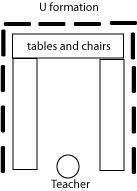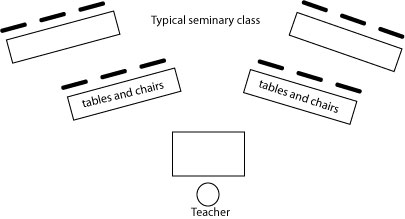I promised to write about this lesson some time ago, but hadn’t gotten around to it.
The weekend before I taught this lesson was inservice meeting. For me, the actual lesson material is easy. I don’t have any trouble reading a passage and picking out something awesome to share or have the kids discuss. What I need is “techniques”. Now I know that you’re probably reading “gimmicks” here. I don’t mean cutesy little games and stuff to entertain my kids while slipping in a gospel golden nugget or two, I’m talking about actual techniques that teachers use that help them own and control a classroom so they can get maximum participation from their students.
You know how it is — sometimes a teacher stands up in Relief Society, and there’s something about them that makes you want to listen. You want to participate. You’re focused. And there are other teachers who stand up and are easy to ignore. Your mind ends up wandering, and you’re not engaged. I’ve been trying to watch other teachers to see what seems to work for them and what doesn’t. I had the opportunity to watch a few really great teachers in action at the Seminary Inservice meeting the other weekend. I also read a couple of teaching books like Becoming a Great Gospel Teacher (which I didn’t find very helpful) and Teach Like a Champion (much more helpful for me). I’m trying to learn and use some of these techniques to help with my teaching.
So at this inservice meeting, I had the privilege of sitting in Brett Barraclough’s class. I don’t know what exactly he does now with Seminary, though it has something with teaching Seminary by video, possibly online. He is a former instructor at West Point. Dude is the bomb. He had a way of teaching that drew you in, but what was more, he told us how he was doing it: with his eyes and proximity. I’m totally ready to go to West Point now. Wonder if they’d accept a momma? :)
So one of the questions that came up during this class was from a teacher who teaches in a basement, like I do. She was complaining that the kids in the back of her room fall asleep and don’t pay attention. Brother Barraclough asked her how she had her class set up. It was in the typical ladder formation you’ve seen a thousand times.

Brother Barraclough told her that a more effective classroom set up was the U-formation. This helps remove barriers between the student and the teacher. There’s “nowhere to hide”, as he put it. Students are more engaged because they feel they can be called on at any time.

I have also found that the U-shape works best in my class. I am most interested in fostering group discussion. With a u-shaped table organization, the kids are looking at each other. I can approach them directly to look at their work, check if they are on the right page, give them a high 5 when they say something awesome, tap them on the shoulder if they are being naughty, etc. Additionally, I feel it’s important for them to look at each other’s faces while we discuss these spiritual topics.
There’s one other benefit, too, to the u-shape that I hadn’t thought of before now. There’s always that kid (or kids), usually female, who will look with disdain upon any miscreants (usually male). You know: the shushers. The dirty look of a peer is so much more effective than any correction you will give, and it could fix many potential problems before they even begin. I do have a few kids who will call the others out, which means I don’t have to. It helps me be the Teacher without having to always be the Evil Tyrant, too.
For a few days, when I was trying to figure out how to fit the extra 2 kids in my basement, I put the tables in a ladder formation. The kids were very quiet. Now, I won’t lie, this was sort of a welcome break. And I did set the rows up so that I could walk up to the kids at the end of the table and I still tried to engage them. The problem was, they weren’t engaging with each other as much. I suppose that the back of someone else’s head just really isn’t all that interesting to talk to.
I group my kids by zones, or teams, of 4, one of whom is the zone leader. They have to sit with their zones, which helps me separate some of the talkers.
Whenever I visit a new building, I take a look at how other Seminary teachers are setting up classrooms. Most of the teachers that I see teaching Seminary teach using some variation of this:

You can immediately see that this is probably the least effective classroom set up in terms of engendering discussion. It’s also the set up that is going to increase texting and acting out during class. Kids feel separated from their teachers and each other in this kind of set up, so they lose interest and are more free to misbehave. They also don’t comment as much, in my observation.
I’ve also seen this boardroom type set up:

This felt really awkward to me, but I think that the reason this setup was being used is that first, this was in a wealthy area of Connecticut where the *teacher* was probably very comfortable in this boardroom setup, and second that the room seemed to only have these gigantic wooden tables. It may have been a high council room. It was pretty bad, because the tables were just too big for the room. This boardroom arrangement, however, was better than the typical set up, because the teacher was free to move around the room behind the students and get closer to them. I think you could make this work, but you’d really have to own the room and move around.
I tested this theory of the barriers when I taught this lesson on Joshua. Normally in our class we sit at the couches around the TV to sing our opening hymn. Then we move to the tables (u-shaped) to have our lesson. Today the kids asked if they could stay on the couches since there were several kids absent, so I said okay. I taught the object lesson and then retreated behind the tables where my lesson materials were setup. I couldn’t get the class to stop talking. Now I strongly encourage on-topic discussion, but I don’t like chatting. About 2/3 of the way through the lesson I remembered what Brother Barraclough had been teaching about barriers, and I picked up my stuff and moved around the tables, closer to the kids. The effect was immediate. The kids were on task, focused. I didn’t change anything about my lesson at all, except my position relative to the students, and that made a huge difference. There was no longer a table between us, and I was within 6 feet of them.
I’m finding that for me, 6-8 feet seems to be the magic distance. When I’m farther away than that the kids act up or have trouble staying focused. That distance doesn’t have to be maintained all the time, but it has to happen throughout the lesson. I have to move around a bit to keep those on the farther edges engaged. I usually do that by approaching someone who is answering a question, by coming closer a few feet. Somehow this helps direct the kids attention to the speaker and helps any who are outside my 6-8 feet pay attention. Who knows — I might approach them next, right?
Another suggestion Brother Baraclough made was that you should try to rearrange the classroom sometimes. He suggested she do a u-setup without the tables. I can tell you making little changes works with teenagers very well. I’ve speculated that this is because their brains crave novelty, and it was affirming to hear another seasoned teacher come to the same conclusion. For me, if an activity does not require tables, I don’t use them. We sit on the couches and chairs in a u-shape. Sometimes we’ll do centers, and rotate between stations. I’ll set up the stations in different locations.
The temporary change helps the kids engage better when you go back to the regular form as well, I’ve found. They’ve had a little novelty, and the familiar old set up is sort of like a relief, almost. A change of pace seems to help them. I don’t suppose that should really be a shock, but I think many teachers don’t consider changing up the classroom for a day or two as a method for improving classroom behavior.
Distance, too, can be a barrier. At our Relief Society meeting last Thursday, the RS counselor in charge was trying to get the ladies to hush so she could begin. She somehow thought that by standing with her arms crossed, scowling, 20 feet in front of 50 women and girls in a gym would make us magically be quiet. I see this a lot, especially in meetings of women. Their frowning, “I’ll wait,” is their passive-aggressive way of guilting us into good behavior.
I admit it, I used to do it when I was first conducting Relief Society, too.
But I didn’t like the way it made me feel: I was constantly annoyed at the sisters for talking. I came to decide that I’m actually really glad they’re conversing. Those conversations are going to help build friendships and help them feel comfortable in class. For me, I found that just starting my introduction helped. I would say a few words — not super loudly, but louder than my normal voice, pause, say a few more, pause, and after a few seconds they’d shut themselves up. The shushers would do the dirty work, and I’d just be the smiling face welcoming them to Relief Society. You have to be confident that what you have to say will engage your class members. You should be smiling. You should be happy to be there and confident about the value of what you’re saying, instead of shaming your audience for enjoying themselves.
Brother Baraclough taught that it was essential to use your eyes to engage students. That’s very, very difficult to do when you have distance barriers or many physical barriers between you and your students. He felt this was super important, and I believe him. I’ve been trying to engage my students more with my eyes, too. I don’t know if it’s making a huge difference or not, but I do think it helps them feel that I’m really listening to them. I’m learning the importance of squaring up, holding still, and looking directly at them when they speak, but I don’t think I’m locking eyes the way he was demonstrating. I will try to do that better and see how it helps.
So anyway, I learned a good bit about the importance of removing as many barriers between my students and me as I possibly can. I’ve felt this intuitively, but it was exciting to see it work so quickly during class the other day.
And now, here’s the lesson I promised:
Joshua 2, 6
The kids summarized the story of the fall of Jericho.
I then assigned a student to build a city and wall out of some wooden blocks I had on the coffee table. He had 2 minutes to make as strong a structure as he could. I asked another student to see if she could knock down the tower by yelling.
Before she even yelled, she said the important thing: “it’s impossible”.
Here was our discussion questions:
– What impossible tasks did the Lord help the Israelites accomplish?
– How were these miracles accomplished?
– Together, let’s make a list of weaknesses that people may think are impossible to change.
– Which of these things does the Lord have the power to change?
– How do you know?
Again, I had thought that we’d have time for scripture mastery, but these kids are getting so comfortable summarizing their reading and then discussing it in depth that there was not time.
I can’t say this was a fantastic lesson at first, but the tide changed dramatically when I moved from behind the tables and got closer to the kids. It definitely ended on a good note.
We did scripture mastery on Friday. One kid passed off five scriptures that day (the easy ones. he’s one of the new students from Utah — interestingly, his Utah release time teacher didn’t encourage scripture memorization at all)! All passed off at least one and some did two or three.


